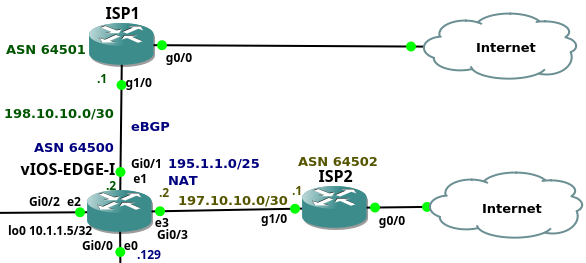Heptio Sideswipes Other Container Distros with ‘True’ Kubernetes Platform
 The HKS container platform is targeted at technically sophisticated organizations.
The HKS container platform is targeted at technically sophisticated organizations.
3 Bad Habits NetOps Should Avoid
Don't make these mistakes when adopting DevOps for production network automation and orchestration.
How Flash Storage Supports Broadway Video’s 4K Growth
All-flash system enables fast, cost-effective production for entertainment and media company.
Enterprise Network on GNS3 – Part 6 – Edge Router and ISPs
This is the sixth article from the series of the articles discussing the configuration of an entire enterprise network. The article explains the configuration of the edge router vIOS-EDGE-I and configuration of ISP routers. Now let's say few words about the router vIOS-EDGE-I. The router is Cisco IOSv Qemu appliance, version 15.6(2)T. It has assigned 512MB RAM by GNS3. The router connects all three parts of the company network to the Internet. These parts are the the campus network, data center and DMZ.

Picture 1 - Company Connection to the Internet via vIOS-EDGE-I
The company has assigned the prefix 195.1.1.0/24. Devices located in DMZ have assigned the prefix 195.1.1.128/25. The prefix 195.1.1.0/25 is assigned for devices hidden behind NAT. NAT is configured on vIOS-EDGE-I router, translating campus and data center subnets to the subnet 195.1.1.128/25. The router is connected to the upstream providers via their Ethernet ports Gi0/1 and Gi0/3. This is a single multi homed topology when a company is connected to two upstream providers with a single edge router. The entire prefix 195.1.1.0/24 is advertised to the both ISPs via BGP routing protocol. Continue reading
Enterprise Network on GNS3 – Part 6 – Edge Router and ISPs
This is the sixth article from the series of the articles discussing the configuration of an entire enterprise network. The article explains the configuration of the edge router vIOS-EDGE-I and configuration of ISP routers. Now let's say few words about the router vIOS-EDGE-I. The router is Cisco IOSv Qemu appliance, version 15.6(2)T. It has assigned 512MB RAM by GNS3. The router connects all three parts of the company network to the Internet. These parts are the the campus network, data center and DMZ.

Picture 1 - Company Connection to the Internet via vIOS-EDGE-I
The company has assigned the prefix 195.1.1.0/24. Devices located in DMZ have assigned the prefix 195.1.1.128/25. The prefix 195.1.1.0/25 is assigned for devices hidden behind NAT. NAT is configured on vIOS-EDGE-I router, translating campus and data center subnets to the subnet 195.1.1.128/25. The router is connected to the upstream providers via their Ethernet ports Gi0/1 and Gi0/3. This is a single multi homed topology when a company is connected to two upstream providers with a single edge router. The entire prefix 195.1.1.0/24 is advertised to the both ISPs via BGP routing protocol. Continue reading
First Speakers in Building Next-Generation Data Center Online Course
Although it’s almost three months till the start of the Building Next-Generation Data Center online course, we already have most of the guest speakers. Today I’d like to introduce the first two (although they need no introduction).
You might have heard about Russ White. He was known as Mr. CCDE when that program started and recently focused more on data centers, open networking and whitebox switching. He’s also an authority on good network design and architecture, network complexity, and tradeoffs you have to make when designing a network.
Read more ...Don’t Miss Our LIVE CCNA Kickoff Tomorrow!
Tune into our live CCNA Kickoff session to get advice from a seasoned professional on what to expect during the CCNA Certification exam, and how to pass the first time.
When: February 1st at 10 am PST/ 1 pm EST
Estimated Length: 3 hours
Instructor: Keith Bogart CCIE #4923
Cost: FREE
Who Should Watch:
This webinar is for anyone and everyone! Since this webinar is geared towards those who are just starting out on their journey towards CCNA certification, no prior knowledge is needed in order to participate, just an interest in earning your CCNA.
What We’ll Discuss:
We will cover common trouble areas that most people experience when getting started with their CCNA certification, such as how to approach making a study schedule and strategies for not becoming overwhelmed by the sheer quantity of topics to be learned. We will also discuss the testing experience and the CCNA Certification test format. Topics include: Deciding whether to take one test or two to get your CCNA, What to expect when you walk into the testing center, which topics to study and how in depth, and what study tools can be useful. Last, Keith will talk about his own experience taking Continue reading
Ericsson Job Cuts Top 10K in Q4 as Downward Spiral Continues
 Ulf Ewaldsson, who played a key role in developing the company’s 5G vision, will leave the executive team.
Ulf Ewaldsson, who played a key role in developing the company’s 5G vision, will leave the executive team.
CA Technologies Boasts Highest Revenue in 4 Years in Q3 2018 Earnings
 The company integrated two acquisitions during the quarter.
The company integrated two acquisitions during the quarter.
